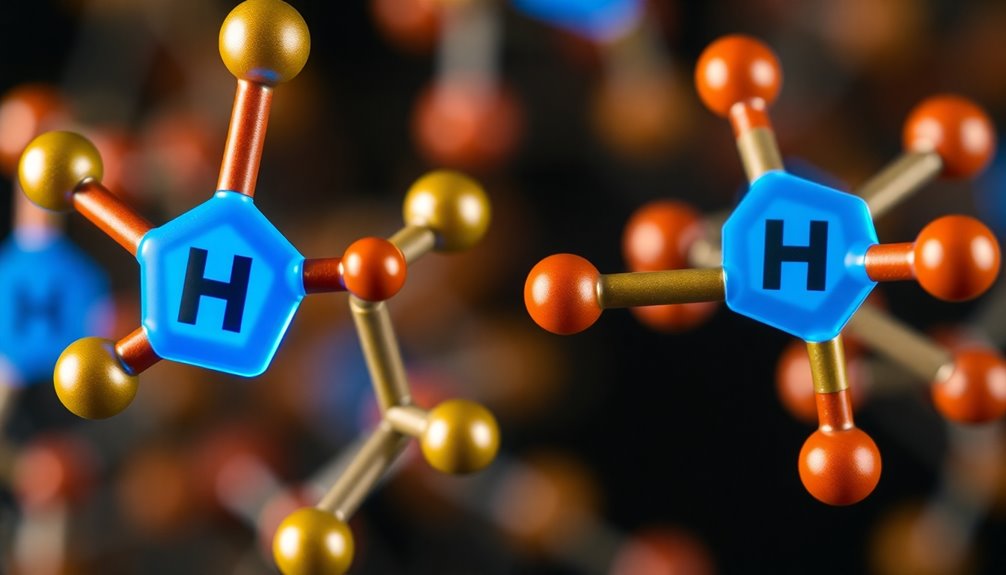Aliphatic and aromatic compounds differ mainly in structure. Aliphatic compounds have linear, branched, or cyclic carbon chains that consist of single carbon-carbon bonds. In contrast, aromatic compounds feature cyclic structures with alternating single and double bonds. This gives aromatic compounds unique stability due to resonance. Aliphatic compounds are typically nonpolar and water-insoluble, while aromatic compounds can stabilize due to their cyclic nature. The distinction affects their uses, with aliphatic compounds commonly found in fuels and aromatic compounds prominent in pharmaceuticals. There's much more to explore about their properties and applications.
Key Takeaways
- Aliphatic compounds consist of linear, branched, or cyclic carbon chains with single bonds, while aromatic compounds have cyclic structures with alternating double and single bonds.
- Aliphatic compounds are generally nonpolar and water-insoluble, whereas aromatic compounds exhibit resonance stabilization and unique chemical properties.
- The general formula for aliphatic compounds (alkanes) is CₙH₂ₙ₊₂, while aromatic compounds do not follow a fixed formula.
- Aliphatic compounds are commonly used as fuels and solvents, while aromatic compounds are valuable in pharmaceuticals and dyes.
- Aliphatic compounds have maximum hydrogen atoms for a given carbon count, while aromatic compounds have fewer due to their cyclic structure.
Definitions of Aliphatic and Aromatic Compounds

Aliphatic and aromatic compounds represent two fundamental classes of organic molecules.
Aliphatic hydrocarbons are characterized by carbon chains that can be linear, branched, or cyclic, containing single carbon-carbon bonds. These compounds can be saturated (alkanes) or unsaturated (alkenes and alkynes), and they typically have a higher carbon-to-hydrogen ratio.
On the other hand, aromatic hydrocarbons feature cyclic structures with alternating single and carbon-carbon double bonds, creating a conjugated ring system. The presence of these conjugated double bonds gives aromatic compounds unique chemical properties.
While aliphatic compounds are often nonpolar and insoluble in water, aromatic compounds exhibit resonance stabilization due to their ring structure, which can also incorporate heteroatoms, leading to various derivatives.
Properties of Aliphatic Compounds

When exploring the characteristics of aliphatic compounds, you'll find that they primarily consist of single carbon-carbon bonds, which contributes to their unique properties.
These hydrocarbons are defined by their structure and behavior:
- They've the maximum number of hydrogens for a given number of carbon atoms, often resulting in a higher number of hydrogen atoms compared to aromatic compounds.
- Aliphatic compounds are generally nonpolar and insoluble in water, although polar functional groups can make them water-miscible.
- They're highly flammable and commonly used as fuels, with examples like methane and butane.
Their boiling and melting points increase with molecular weight and branching, greatly affecting their physical properties in organic chemistry.
Properties of Aromatic Compounds

Aromatic compounds, known for their distinct cyclic structures, possess unique properties that set them apart from other hydrocarbons. They feature alternating double and single bonds within their conjugated system, with the benzene ring being the simplest and most recognized example.
This structure leads to remarkable stability due to resonance, stemming from the delocalization of π electrons across the ring. Even heteroaromatic compounds, which include atoms like nitrogen or oxygen in the ring, maintain this alternating bond pattern and exhibit aromaticity.
The chemical properties of aromatic compounds make them particularly valuable in the pharmaceutical industry, serving as essential building blocks for various drugs and organic materials. Their distinct characteristics play a significant role in numerous applications.
Examples of Each Compound Type

Understanding the types of compounds is key in organic chemistry, and you'll find that both aliphatic and aromatic compounds play significant roles in various applications. Here are some examples to take into account:
- Aliphatic hydrocarbons: Hexane (C₆H₁₄) is a linear alkane, while cyclohexane (C₆H₁₂) features a cyclic structure, both containing only single bonds.
- Aromatic compounds: Benzene (C₆H₆) showcases a cyclic structure with alternating double bonds, giving it unique stability and reactivity.
- Functionalized versions: Aniline (C₆H₅NH₂) incorporates an amino group, demonstrating how a nitrogen atom can enhance aromatic compounds, while isopropanol (C₃H₈O) retains its aliphatic nature despite having a hydroxyl group.
These examples highlight the diversity and importance of both compound types in organic chemistry.
Key Distinctions Between Compounds

While both aliphatic and aromatic compounds are essential in organic chemistry, they differ considerably in structure and properties. Aliphatic hydrocarbons consist of single carbon-carbon sigma bonds and can be linear, branched, or cyclic. In contrast, aromatic compounds feature cyclic structures with alternating double and single bonds, which give them unique stability.
| Feature | Aliphatic Compounds | Aromatic Compounds |
|---|---|---|
| Structure | Non-cyclic, single bonds | Cyclic, alternating double bonds |
| General Formula | CₙH₂ₙ₊₂ (alkanes) | Does not follow a fixed formula |
| Common Uses | Fuels, solvents | Pharmaceuticals, dyes |
These distinctions influence their properties and applications, making each type uniquely valuable in various fields.
Frequently Asked Questions
What Is the Difference Between Aliphatic and Aromatic Amino Acids?
Aliphatic amino acids have straight or branched hydrocarbon side chains, making them typically nonpolar and hydrophobic.
In contrast, aromatic amino acids include a benzene ring in their side chains, giving them distinct properties. This difference affects their solubility in water, with aromatic amino acids being more polar.
Aromatic amino acids are essential for protein structure and function, while aliphatic amino acids are more abundant in proteins, contributing to various biological processes.
What Is the Difference Between Aliphatic and Aromatic Resin?
Absolutely, aliphatic resins are flexible friends, often featuring linear or branched structures that make them perfect for coatings and adhesives.
In contrast, aromatic resins are rigid rivals, boasting cyclic structures and offering higher thermal stability for demanding applications.
You'll find aliphatic resins cure quickly, while aromatic ones require a more complex curing process.
What Is an Example of an Aliphatic Compound?
An example of an aliphatic compound is hexane, which you might encounter in various applications such as fuels or solvents.
It's a straight-chain alkane made up of carbon and hydrogen atoms connected by single bonds. You'll notice that aliphatic compounds like hexane typically have a higher hydrogen count than other types of compounds.
Other examples include isopropanol, a common alcohol, and cyclohexane, which has a cyclic structure.
Conclusion
In the world of chemistry, aliphatic compounds are like the sturdy, straight roads that connect various destinations, while aromatic compounds are the winding, fragrant paths lined with flowers, rich in complexity. Understanding these differences not only enriches your knowledge but also opens doors to the vibrant landscape of organic chemistry. So, as you explore these compounds, think of them as the unique threads in the intricate tapestry of molecular structures that shape our world.










